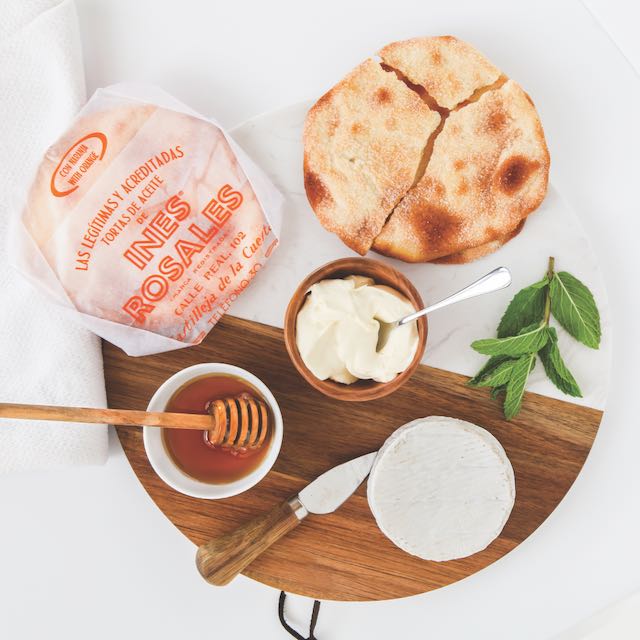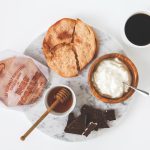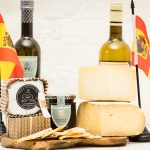
Inés Rosales founded her namesake company in 1910 in a small town outside of Seville called Castilleja de la Cuesta. She began making traditional cakes called olive oil tortas, using a traditional, age-old family recipe passed down from generation to generation. Spain went through a civil war in the late 1930s, and even through hard times, tortas remained popular due to their affordability, and eventually became a part of everyone’s everyday lives. Demand for Inés’ tortas grew and she continued to grow her business; in the process, she became one of the first woman entrepreneurs of her time.
What’s in a Name?
Depending on where you’re from, the word torta might conjure up different images. In Mexico, torta is a sandwich, in Columbia, a cake made with candied fruits. In southern Spain, it’s a light and crispy baked good.
Ines Rosales knew that bringing their product to other countries could potentially confuse customers, but they didn’t want to change the name of the product and lose their identity in the process. They decided to keep calling it torta and add the description of a “fine Mediterranean crisp.” Clearly, customers weren’t too confused to enjoy them, since they’re now sold in over 30 countries and are an international favorite!
How the Tortas Are Made

Today, the tortas are still handmade (400,000 tortas a day!) and they still use the original recipe from Inés Rosales’ family cookbook, with only a handful of ingredients—wheat flour, premium quality extra virgin olive oil, sugar, and aromatic spices. And never any preservatives or artificial ingredients. The flavors reflect their Mediterranean heritage and all of the ingredients in these tortas are regionally-sourced. Plus, the olive oil has been recognized by UNESCO as an Intangible Cultural Heritage of Humanity. It’s a testament to the quality of the product, that over the years they’ve acquired a number of certifications without ever having to change the recipe.
The tortas combine the best of both worlds: a very artisanal kneading and hand-patting process with state-of-the-art packing machinery. The labradoras—the wonderful ladies who shape every single torta by hand, leaving their unique touch in each one—have a challenging role. They’re working with a very sticky dough, about 25% extra virgin olive oil, and it’s essential to get just the right thickness—a torta that’s too thick won’t be fully cooked and one that’s too thin is overcooked. On average, it takes about six months to learn the craft before they’re able to be working in the production line. It’s a hypnotizing process to watch, and if you’re ever visiting Seville, you’re welcome to visit the factory and see it in person.
How to Enjoy Tortas
In Spain, tortas are usually eaten as is, with coffee or tea, either for breakfast or an afternoon snack. In America, they’re most often paired with cheese. But there’s no wrong way to enjoy tortas! As Lucía Conejo-Mir, VP of Sales North America at Ines Rosales says:
The only proper way to eat a torta is to be present. Enjoy the moment of unwrapping the torta, cutting it into pieces, and sharing it with somebody. It’s the ritual, it’s the only right way to eat the torta. As for what you pair it with, whatever pleases your senses.
Tortas are a ritual, a moment of tranquility, something to be enjoyed, it’s kind of the Spanish lifestyle. Whenever we work, we work, but we work to live. We don’t live to work. So when we’re living, we ARE living, and we try to be present and we try to enjoy the moment.
If you like the idea of a torta for breakfast, but want a little more substance, follow Lucía’s suggestion of replicating a typical Spanish breakfast of toast with extra virgin olive oil, tomato (either blended or sliced), and slices of Iberico ham, replacing the toast with a torta. Or, swap a torta in place of a bagel and top it with cream cheese and lox.

Torta Flavors and Serving Suggestions
Original (with Anise) Tortas
Spread these handmade tortas with the Creamery’s handmade cream cheese for breakfast. Pair them with manchego—like Golden Fleece, a young manchego made with saffron-infused sheep’s milk—and quince paste. Or enjoy them with goat cheese, a little bit of strawberry jam, and some nuts.
>Shop these tortas online at the Deli
Cinnamon Tortas
Pair these with yogurt, a little bit of honey, and some chocolate. Try them with a French triple-cream—like Regal Raisin, which is covered with raisins soaked in Marc de Bourgogne—it’s almost like a bite of cheesecake. Or, follow the lead of our Tasting and Events Coordinator, Tessie Ives-Wilson, and make a twist on an ice cream sandwich: snap one in half and gently layer a little vanilla gelato in the middle.
> Shop these tortas online at the Deli
Orange Tortas
Made with bitter Seville oranges, these pair well with brie, fig jam, and some Marcona almonds. Or try them with a more intense cheese, like The Stag, a Midwestern white cheddar, or Bayley Hazen Blue, dense and fudgy with less of a bite than a Stilton.
>Shop these tortas online at the Deli
Sesame and Sea Salt Tortas
Pair these with manchego, Marcona almonds, and quince paste.
Rosemary & Thyme Tortas
Pair these with salami, roasted tomatoes, burrata, and maybe a glass of red wine. Or use pieces in place of croutons in a salad.



